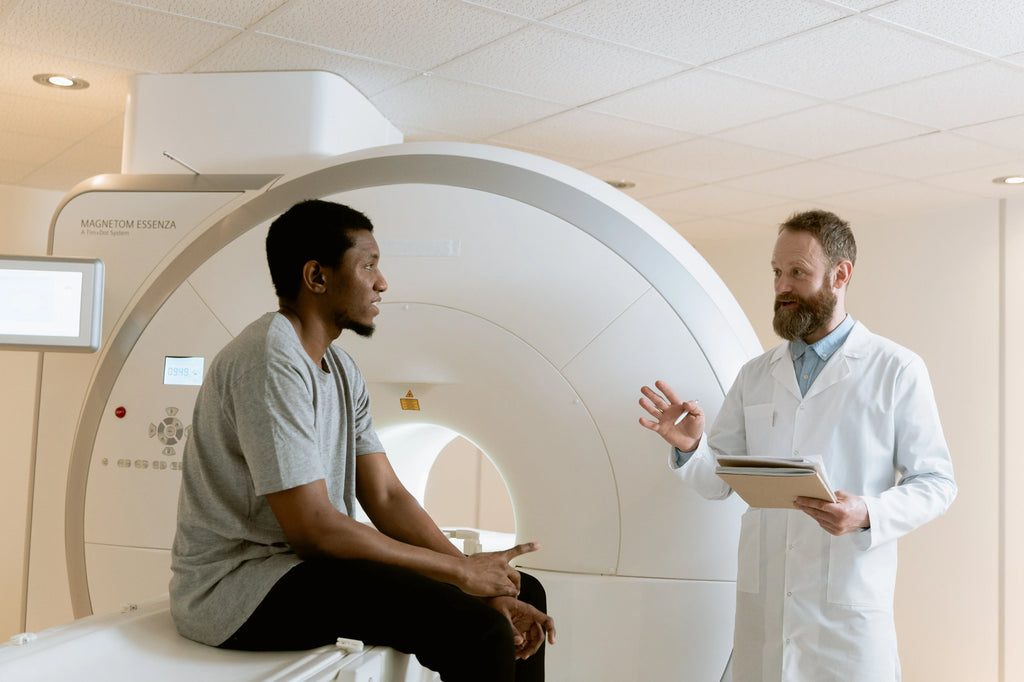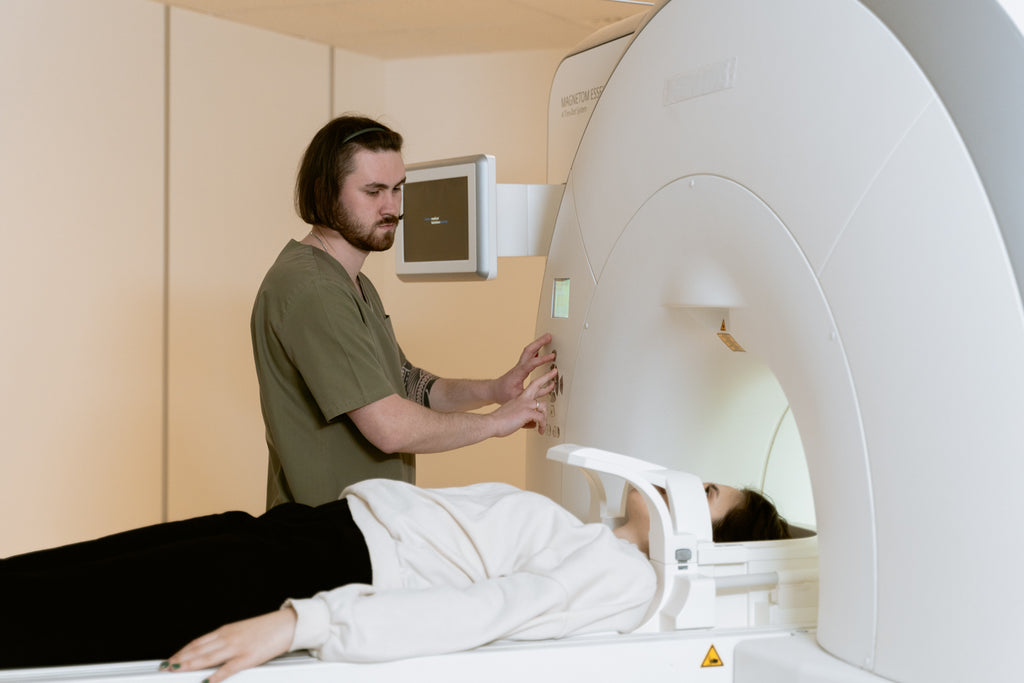The Dual Energy CT Scan (DECT) Procedure Explained
If you have an upcoming dual energy CT scan (DECT), you might be unsure exactly what is it and why you would need one.

Image courtesy of MART PRODUCTION
You will need to prepare for your upcoming scan so it's important to know what to expect when you arrive at the healthcare facility.
What is a Dual Energy CT scan?
Dual energy computed tomography (DECT), also known as spectral CT, is an essential imaging and diagnostic technique used by radiologists around the world.
These DECT procedures involve using simultaneous but separate x-ray photon energy spectra to produce cross-sectional images (slices) of an area inside the body. Usually, these cross-sections are around 1mm thick.
The properties of different materials having unique attenuation profiles at different levels of energy can be used by the machine to produce a series of high-quality images [1]. This is unlike conventional single energy CT that provides just a single image set, DECT manipulates energy at two levels, which gives healthcare professionals a deeper look into the body.
The series of images that are produced can be added together, subtracted, or post-processed to form a 3D interpretation or highlight unique pathology.
What are the benefits of the dual energy CT Scan (DECT) procedure?
There are a few key benefits to the dual energy CT scan procedure. Each produce added clarity or effectiveness of the procedure, and include each of the following:
Improved contrast agent effect:
Selectively boost the effects of chemical agents administered in the body, usually given through the veins, to make images clearer.
For example, in a CT angiogram of the head and neck, dual energy CT is often used to enhance the iodine contrast agent to highlight the blood vessels to evaluate causes of stroke or headache.
“Virtual non-contrast”
An extra set of “non-contrast” images can be automatically generated from a single DECT contrast scan to avoid a repeat scan.
Metallic artifact reduction
When metal is present within the body this can cause image streak artifact (beam hardening artifact) with single-energy CT. This commonly occurs with knee/hip replacements, stabilizing screws in the spine, or fixator rods through fractures, for example.
DECT can reduce the artifact by a great amount to enable evaluation of the important surrounding tissues that would otherwise be obscured.
Minimum increase in radiation exposure
As contrasted to other types of computed tomography, there is little to no additional radiation exposure on the newest CT scanners.Why would I need a dual energy CT?
The dual energy CT technique is an adjunct to conventional CT. However, there are a few different reasons why you might be sent for a dual energy CT scan by your doctor.

Image courtesy of MART PRODUCTION
Here are some of the most common situations or medical health conditions that warrant further investigation via a dual energy CT:
Gout
Joint pain can be a diagnostic challenge, especially when gout is suspected clinically but all tests have been negative. DECT is extremely accurate for detecting these uric acid deposits causing gout inflammation.
A 3D image can be generated to pinpoint the location of these deposits, even those within the tendons and soft tissues outside of the joint.
Postoperative back pain and joint pain
DECT with metallic artifact reduction can reveal pathology that would otherwise be obscured by streak artifact.
Kidney stone evaluation
Preoperative assessment of different composition of urinary tract calculi such as uric acid or calcium stones may influence treatment.
How do I prepare for my DECT procedure?
Depending on where in the body you are getting scanned, the amount of DECT procedure preparation that is required will differ.
CT scans of the bones and brain are generally will require very little preparation. However, there are certain types of dual energy CT where a pre-scan injection of iodinated contrast material is necessary to produce strongly contrasting images of the blood vessels or organs.
When this is the case, the healthcare professional will advise you to abstain from food at least 2 hours before the scan. Usually, you can drink water in the time just before the scan.
A test injection is necessary to rule out the risk of any adverse reactions that you might have to the iodinated agent. You may be asked to drink a contrast solution an hour beforehand if your abdomen is being scanned.
You may be asked to change into a hospital gown to avoid clothing getting in way of the scanner.
What should I expect during my dual energy CT procedure?
Dual energy CT scans are performed by a large circular scanner inside the radiology department of the healthcare facility. You will either enter the scanner head first or feet first depending on which part of the body is being scanned.
To administer the iodine contrast solution into the bloodstream for the scanning of blood vessels or specific organs, a small cannula (plastic tube) will be inserted into your vein. This is sometimes hooked up to a pump that will release a small amount of the agent at a set rate so the CT scanner can target specific areas of the body.
When the agent enters the blood, you may feel a slightly metallic taste in your mouth and a warm sensation running through your body. However, these things will likely stop after a few minutes.
The bed will slide in and out of the CT scanner multiple times to get several cross-sectional images. You may be asked by the radiographer to hold your breath for part of the scan. In most cases, the scan is complete in only five minutes.
Once your DECT scan is complete, your cannula will be removed, and you will be assisted into the waiting area ready to go home or back up to the ward if you’re an inpatient.
The length of time until you get your results varies depending on several factors.
If your scan is urgent, complex, or needed as part of ongoing treatment for a long-term condition, you are likely to get the results back quickly so that your doctors can make quick decision on the next steps in your treatment plan.
What are the risks of having the DECT procedure?
There aren’t side effects specific to dual energy CT scans that aren’t associated with other imaging techniques.
However, dual energy CT scanners can often use higher doses of radiation than single energy CT scanners. There is also the potential for patients to have adverse reactions to the iodinated contrast solution. Some people can be allergic to the contrast.
Reactions usually start off mild but have the potential to become life-threatening if not treated [2].
Although it is difficult for healthcare professionals to predict this, radiologists are trained to deal with allergic reactions. You should always disclose any allergies that you know of to the medical staff prior to your scan to minimize the risks of the CT scan.`
Want to book an appointment with a radiologist in Southern California? Give us a call at (562) 906-5572 or schedule an appointment online.
Dual Energy CT Scan Article References
[1] https://appliedradiology.com/articles/dual-energy-ct-in-practice-basic-principles-and-applications
[2] http://citeseerx.ist.psu.edu/viewdoc/download?doi=10.1.1.550.9765&rep=rep1&type=pdf
[3] https://affordablescan.com/blog/ct-scan-cost-near-me/
[4] https://www.newchoicehealth.com/ct-scan/cost
[5] https://www.honorhealth.com/patients-visitors/average-pricing/ct-scan-costs

